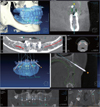Abstract
One of the fastest growing segments of implant dentistry is the utilization of computed tomography (CT) scan data and treatment planning software in conjunction with guided surgery for implant reconstruction cases. Computer assisted planning systems and associated surgical templates have established a predictable, esthetic, functional technique for placing and restoring implants. Especially, a philosophy of restoratively driven implant placement has been generally adopted. Recently, a variety of commercial dental fields have released their scanning and fabricating protocols and methods for restorations. This process is still being investigated and developed for the most precise and predictable outcome. This case report describes a female patient who wanted dental implants in fully edentulous areas. Restoratively driven implant placements were performed with surgical guide and the patient was fully satisfied with the clinical results, and at 5-year post restorative follow-up assessment, both implant and prosthesis were proved clinical success.
Figures and Tables
Fig. 2
Pre-operative intraoral view. (A) Occlusal view of maxilla, (B) Occlusal view of mandible, (C) Frontal view.

Fig. 3
Interim complete dentures were fabricated and radiographic markers were inserted for CT scan. (A) Maxillary denture, (B) Mandibular denture, (C) Frontal view.

Fig. 6
Occlusal index was fabricated to place surgical stent intraorally using interim dentures and putty remount casts. (A) Interim dentures were used to fabricate putty remount casts, (B) Surgical template of maxilla was seated into putty casts, (C) Surgical template of mandible was seated into putty casts, (D) Occlusal index was fabricated to place surgical stent intraorally.

References
1. Lal K, White GS, Morea DN, Wright RF. Use of stereolithographic templates for surgical and prosthodontic implant planning and placement. Part I. The concept. J Prosthodont. 2006; 15:51–58.

2. Lal K, White GS, Morea DN, Wright RF. Use of stereolithographic templates for surgical and prosthodontic implant planning and placement. Part II. A clinical report. J Prosthodont. 2006; 15:117–122.

3. Ozan O, Turkyilmaz I, Ersoy AE, McGlumphy EA, Rosenstiel SF. Clinical accuracy of 3 different types of computed tomography-derived stereolithographic surgical guides in implant placement. J Oral Maxillofac Surg. 2009; 67:394–401.

4. van Steenberghe D, Naert I, Andersson M, Brajnovic I, Van Cleynenbreugel J, Suetens P. A custom template and definitive prosthesis allowing immediate implant loading in the maxilla: a clinical report. Int J Oral Maxillofac Implants. 2002; 17:663–670.
5. van Steenberghe D, Glauser R, Blombäck U, Andersson M, Schutyser F, Pettersson A, Wendelhag I. A computed tomographic scan-derived customized surgical template and fixed prosthesis for flapless surgery and immediate loading of implants in fully edentulous maxillae: a prospective multicenter study. Clin Implant Dent Relat Res. 2005; 7:S111–S120.
6. Parel SM, Triplett RG. Interactive imaging for implant planning, placement, and prosthesis construction. J Oral Maxillofac Surg. 2004; 62:41–47.

7. Marchack CB. An immediately loaded CAD/CAM-guided definitive prosthesis: a clinical report. J Prosthet Dent. 2005; 93:8–12.

8. Balshi SF, Wolfinger GJ, Balshi TJ. Surgical planning and prosthesis construction using computed tomography, CAD/CAM technology, and the Internet for immediate loading of dental implants. J Esthet Restor Dent. 2006; 18:312–323.

9. Balshi SF, Wolfinger GJ, Balshi TJ. Surgical planning and prosthesis construction using computer technology and medical imaging for immediate loading of implants in the pterygomaxillary region. Int J Periodontics Restorative Dent. 2006; 26:239–247.
10. Kupeyan HK, Shaffner M, Armstrong J. Definitive CAD/CAM-guided prosthesis for immediate loading of bone-grafted maxilla: a case report. Clin Implant Dent Relat Res. 2006; 8:161–167.

11. Rosner O, Gross M, Nissan J. Use of a provisional restoration as a radiographic guide prior to implant placement. J Prosthet Dent. 2006; 96:303–304.

12. Pjetursson BE, Brägger U, Lang NP, Zwahlen M. Comparison of survival and complication rates of tooth-supported fixed dental prostheses (FDPs) and implant-supported FDPs and single crowns (SCs). Clin Oral Implants Res. 2007; 18:97–113.

13. Goodacre CJ, Bernal G, Rungcharassaeng K, Kan JY. Clinical complications with implants and implant prostheses. J Prosthet Dent. 2003; 90:121–132.





 PDF
PDF ePub
ePub Citation
Citation Print
Print
















 XML Download
XML Download